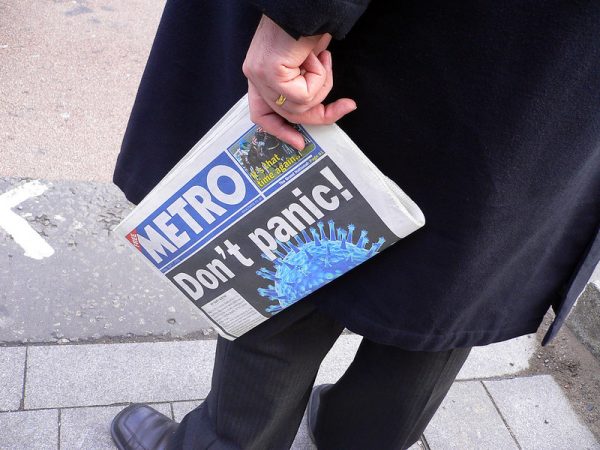
This post was created in collaboration with the Minnesota Journalism Center.
Coronavirus — also known as COVID-19 — has taken the global media world by storm. Over 2,000 have died and more than 79,000 are infected globally. The World Health Organization has been criticized for not declaring a public health emergency earlier than they did, but doctors including Dr. Emily Landon at the University of Chicago are saying that “people shouldn’t panic.”
In cases of public health epidemics, whether people panic depends in part on how journalists cover the issue and which experts they cite. Journalists tend to quote official sources like government officials and public health officials to inform the public about outbreaks of illness including influenza, swine flu, Zika, Ebola, and more recently, coronavirus. Being quoted in news articles gives public health officials the opportunity to share their expertise on said topics to help inform readers about how to protect themselves and avoid infection. From a sociological perspective, focusing on the spread of information about pandemics and infectious diseases provides opportunities for scholars to comment on evolving social structures and processes in a way that will influence the biomedical sciences’ public and policy agenda.
- Mark Davis and Davina Lohm. 2020. Pandemics, Publics, and Narrative. Oxford University Press.
- Robert Dingwall, Lily M. Hoffman, and Karen Staniland. 2013. “Introduction: Why a Sociology of Pandemics?” Sociology of Health & Illness 35(2): 167–173.
- Mark Davis, Davina Lohm, Paul Flowers, Emily Waller, and Niamh Stephenson. 2014. “We Became Sceptics”: Fear and Media Hype in General Public Narrative on the Advent of Pandemic Influenza.” Sociological Inquiry 84(4): 499–518.
As epidemiologist Adam Kucharski wrote in The Guardian, “stories sparking fear seem to have overtaken the outbreak in real life” and misinformation (a topic The Society Pages has written about here) seems to be more contagious than the virus itself. The “need for speed” in publishing journalistic updates about the virus as well as scholarly work has resulted in several retractions, including the retraction of a preprint of a scholarly paper after its analysis was found to be faulty.
Further, the spread of information — and misinformation, including conspiracy theories — about health crises often occurs on social media platforms including Twitter and Instagram. Scholars found that false information spread especially quickly during Ebola outbreaks in West Africa and in the Zika outbreak in Brazil, which led to the formation of counterproductive policies passed by public health officials who struggled to combat false claims. In recent years, Instagram was found to be the most effective platform for health organizations including Centers for Disease Control, the World Health Organization, and Doctors without Borders to engage followers during global health crises.
- John M. Carey, Victoria Chi, D. J. Flynn, Brendan Nyhan, and Thomas Zeitzoff. 2020. “The Effects of Corrective Information about Disease Epidemics and Outbreaks: Evidence from Zika and Yellow Fever in Brazil.” Science Advances 6(5).
- Jeanine P.D. Guidrya, Yan Jin, Caroline A.Orr, Marcus Messner, and Shana Meganck. 2017. “Ebola on Instagram and Twitter: How Health Organizations Address the Health Crisis in their Social Media Engagement.” Public Relations Review 43(3): 477–486.
- Anthony Stefanidis, Emily Vraga, Georgios Lamprianidis, Jacek Radzikowski, Paul L Delamater, Kathryn H Jacobsen, Dieter Pfoser, Arie Croitoru, and Andrew Crooks. 2017. “Zika in Twitter: Temporal Variations of Locations, Actors, and Concepts.” JMIR Public Health and Surveillance 3(2).
Scholars, including Dr. Anita Varma, recently published five tips for journalists on covering coronavirus. These include paying attention to the frames used and including quotes from official sources like government officials as well as the people directly affected by the health concern. Dr. Karin Wahl-Jorgensen published an article on the role that fear plays in narratives about public health crises. The bottom line is: The way stories are told matters and affects the management of pandemics and policy responses.
- Alessio Cornia, Marina Ghersetti, Paolo Mancini, and Tomas Odén. 2016. “The Partisans, the Technocrats and the Watchdogs.” Journalism Studies 17(8): 1030–1050.
- Chi Kit Chan. 2016. “Defining Health Risk by Media Template: Hong Kong’s News Discourse of the Swine Flu Pandemic.” Journalism 17(8): 1018–1036.
- Peter Ruigrok and Nel Vasterman. 2013. “Pandemic Alarm in the Dutch Media: Media Coverage of the 2009 Influenza A (H1N1) Pandemic and the Role of the Expert Sources.” European Journal of Communication.
